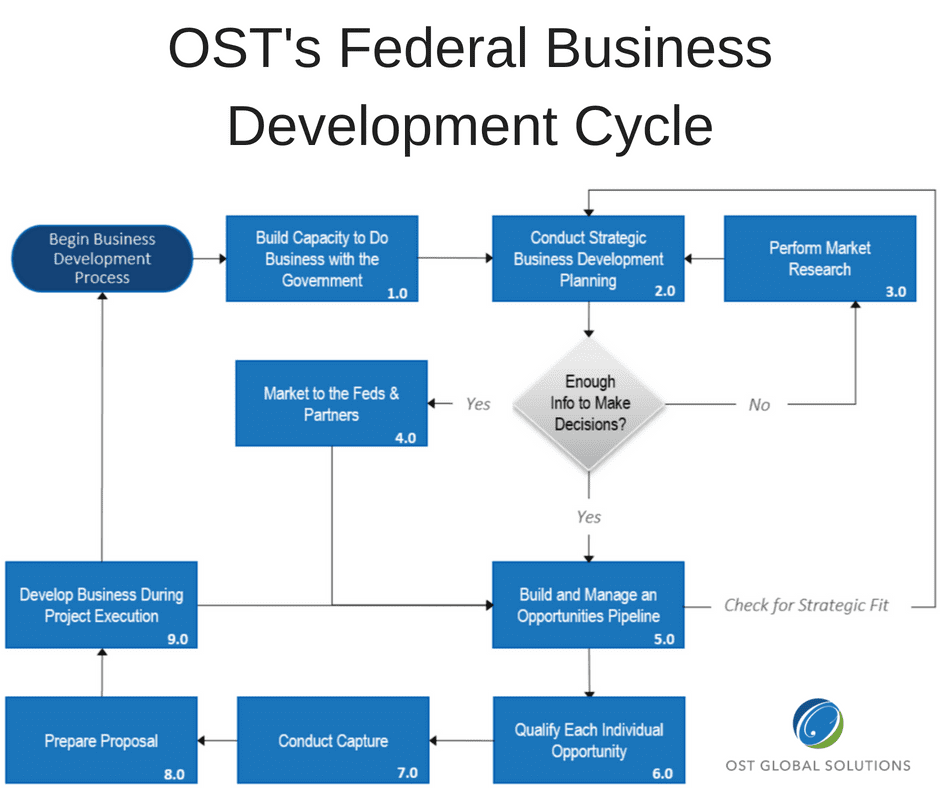We’ve been going through our video archives, and the desire and need to know how to consistently win Government contracts hasn’t decreased in the slightest. Some of the references in the video above may be dated, however, the article contains OST’s current methodologies. The Government’s push for more civilian solutions drives the creation of more small federal contracting companies. In fact, the US Government has continued to put pressure on Government agencies to award at least 23% of all eligible prime contracts to small businesses. Here are some other interesting award goals:
- Small Disadvantaged Business Award Goal: 5% (2017: 9.1%= $40.2B)
- Service Disabled Veteran Owned Small Business Award Goal: 3% (2017: 4.1%= $17.9B
- Women-Owned Small Business Award Goal: 5% (2017: 4.7%= $20.8B)
- HUBZone Award Goal: 3% (2017: 1.7%= $7.3B)
The US Government has hit its goals for the last five years, with the exceptions being WOSB’s and HUBZone businesses. Unfortunately, most small businesses don’t know how to execute their business development in a consistent and organized manner. As a result, out of over 50 million small U.S. businesses, only 200 companies categorized as small businesses won 25% of the $110 billion in prime small business dollars awarded by Government agencies in fiscal 2017.
In our experience, a lack of consistent dedication to business development is the primary reason most small businesses fail to secure these Government contract awards.
“58 million small businesses in the U.S., just 200 companies categorized as small businesses won 25 percent, or $28 billion, of the $110 billion in prime small business dollars awarded by federal agencies in fiscal 2017.” -Washington Examiner
Business Development for Winning Government Contracts
In our experience, companies normally fall into one of two categories for bad BD practices:
Inaction, which is pretty self-explanatory. Companies land one or two profitable contracts and then the pressure to make payroll or close the next deal disappears. If you don’t constantly bid on contracts then you won’t have any revenue streams when your current contracts end. We recently saw a company lose their $250M contract that they’ve had for eight years and they have no other contracts to replace it.
Conversely, it gets more complicated when companies do a lot and see little to no returns. When you submit bids and spend money with nothing to show for it you typically end up going through feast and famine cycles (or just famine). Then you end up hiring people to do your BD for you, but all they know how to do is use their Rolodex and play golf.
These guys you’ve hired, their intentions may be good. They think “I’m from the Government. I know this agency, and I know the customer,” but they probably don’t produce any results.
The Federal Business Development Cycle
Business development has distinct stages. These stages are:
- Build Capacity to do Business with the Government
- Strategic Planning
- Market Research
- Pipeline Development
- Opportunity Identification
- Marketing
- Capture Management
- Proposal Management
- Perform BD during Project Execution
Today, we’re going to discuss the first six in the BD cycle.
Stage 1: Build Capacity To Do Business With The Government
At various points in your company’s development and growth, you will need to add more capabilities and certifications. For example, as your company grows, you may need:
- To earn an ISO or CMMI certification
- A facility clearance to bid on classified contracts
- To add to your business development department (capture or proposal managers)
- A DCAA audit of your accounting system to bid on cost-reimbursement contract
- To have your cost estimating methodology certified
- To establish an earned value management system
As your company grows, you will bid on more contracts. Additionally, you will bid on larger contracts as your ability to deliver larger solutions grows through experience.
Stage 2: Strategic Planning
Many business owners treat strategic planning (or planning of any kind) as an administrative task. But this couldn’t be further from the truth. Planning is actually a huge part of growing your business. However, sometimes, small business owners get so involved in day-to-day tasks that they forget to plan.
The first step you must take in strategic planning is understanding where you’re trying to go. Then you need to look at where you are. Finally, you’ll take a hard look at what it will take to get you from where you are to where you want to be.
We’ve identified four key steps in a successful strategic planning session:
- Recruitment Strategy: who is going to do your business development? Who are you going to hire? Are you going to hire consultants or use your internal staff? If you’re going to use your internal staff, then you must assess which BD skills they lack and plan to train them. You’ll need to take a candid look at your business and your goals and decide if you want to bring in an account manager, capture and proposal team, or even production staff.
- Top-Down BD Budget: This isn’t opportunity specific. You know that BD is critical to your success, and you need to budget for it. You’ve got to set aside dedicated money for business development. After you select an opportunity to pursue, you’ll intentionally spend a lot of money because the gain is worth the expense.
- Ideal Customer Profile: When you develop your ideal customer profile (or buyer persona), you’re essentially describing your perfect customer. If this customer existed, they would be perfect for your portfolio of products or services.
- Target Customers: You probably already have some target customers in mind. However, you need to thoroughly research target customers, markets, and agencies. When you’re finished, you should have an organized list of your priorities and target markets.


